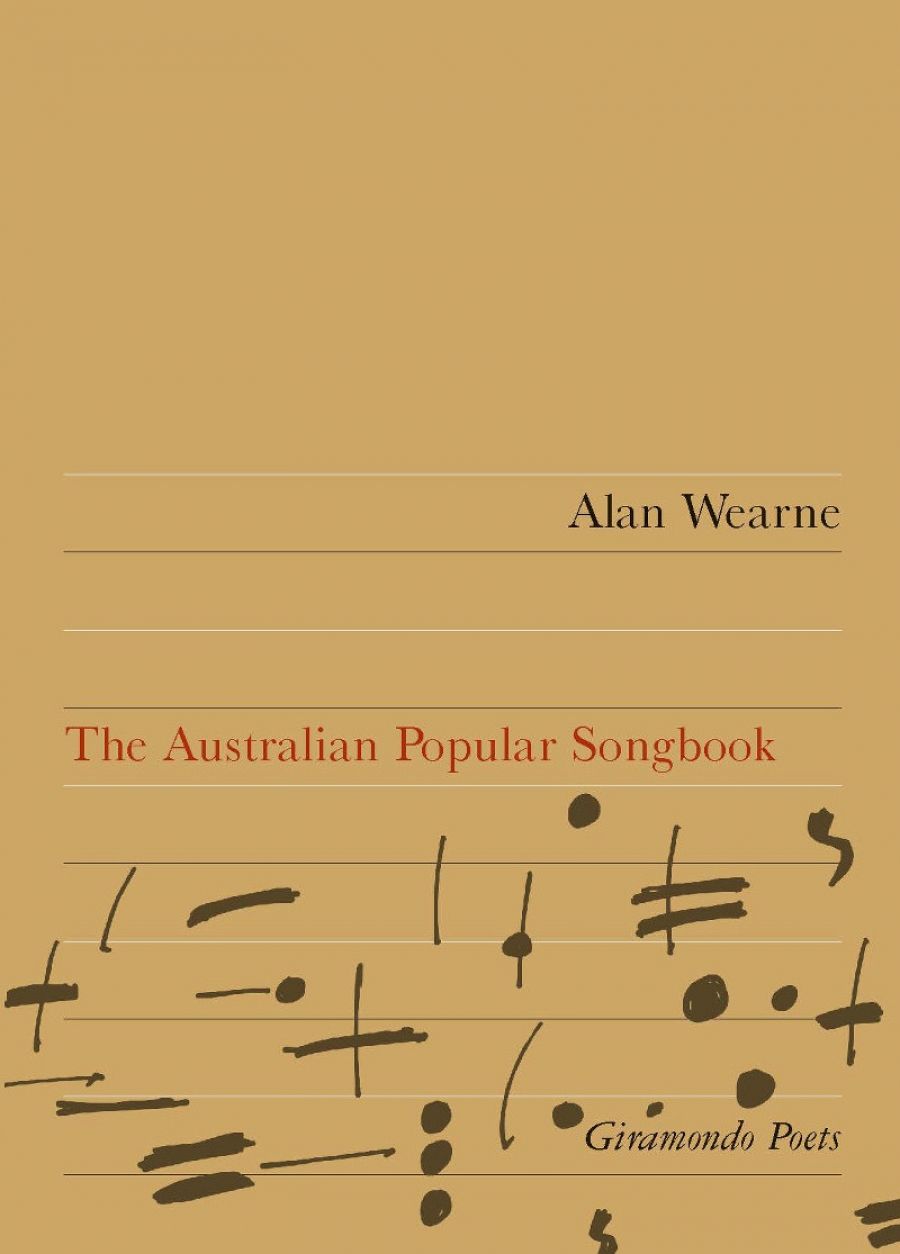
- Free Article: No
- Contents Category: Poetry
- Review Article: Yes
- Online Only: No
- Custom Highlight Text:
Having spent two decades or more writing massive verse novels – The Nightmarkets (1986) and The Lovemakers (2001, 2004) – it may seem that Alan Wearne, with his latest book of poetry, The Australian Popular Songbook, has finally returned to smaller forms and, as suggested by the title, a more lyrical idiom. But, as always with Wearne’s work, things aren’t that simple. The smaller forms were already present in the verse novels in the form of sonnets, villanelles and other verse forms buried in the sprawling architecture of the works’ narratives. The ‘lyrical idiom’ of The Australian Popular Songbook is ambiguous at best, offset as it is by Wearne’s characteristic attraction to the dramatic monologue, satire, vernacular culture and wrenched syntax.
- Book 1 Title: The Australian Popular Songbook
- Book 1 Biblio: Giramondo, $22 pb, 96 pp
In other words, despite the obvious change in scale, the new poems can be seen as a continuation of Wearne’s ‘epic’ project by other means. Wearne’s poetic world remains urban and suburban, idiomatic and stylistically idiosyncratic. We still find characters with names such as Nigel, Larissa, and Jill, and references to suburbs such as Prahran, Box Hill, and Bundoora. We still find well-defined personae, such as the 1960s union organiser, the lesbian Uniting Church minister and the middle-aged high-school teacher from the 1970s. We still find the odd excursion from the suburbs to the demi-monde (‘There’s a fortune a day / just pulling cocks’). Also present are Wearne’s characteristic poetic interests: family, politics, sexuality, gender, and war, with the adjective Australian before all of them. Wearne continues his essays on local culture, with references to Australian films such as Pure Shit, Australian politicians such as Don Dunstan, and Australian television programs such as IMT (which, it should go without saying, is the Graham Kennedy version of In Melbourne Tonight rather than the more recent, but also defunct, reincarnation).
The most obvious attention to local, vernacular culture can be found in the collection’s eponymous sequence, which, naturally, comprises poems that take their titles from popular Australian songs. These range from folk songs such as ‘Bound for Botany Bay’, to oldies such as ‘Bless this House’, 1960s pop hits such as ‘Ciao Baby’, and classic Aussie rock such as ‘Girls on the Avenue’ and ‘Just a Suburban Boy’
As one might expect, these Australian songs are not the poems’ subjects, but instead give the poems resonance and colour. Often enough, that resonance is comic or ironic, as in the hilarious villanelle ‘Come on Aussie’ which has one of its refrain lines reading ‘It’s babyboomer partytime in Oz’ (which, Wearne explains, is ‘the title of a cassette album by Nigel T and the Oz Party People, a Perth-based nostalgia cover band’). At other times, the irony can be more biting, as in ‘I Go to Rio’, one of the few poems to directly address its eponymous song, which does a pretty devastating job on the Peter Allen version of Rio-as-camp.
The trope of popular songs as indices of past times and places is a brilliant one, and one that draws attention to Wearne’s great strength as an evoker of milieux. For Wearne, place cannot be understood without reference to time. This is seen especially in the collection’s second sequence, ‘The Metropolitan Poems’, which includes poems with titles such as ‘Ascot Vale 1953’ and ‘Rose Bay 1959’. Wearne ranges widely in his depiction of Australia, from the early twentieth century to the present, though he seems most comfortable with the decades between 1950 and 1980 (none of the songs in his songbook contains titles from contemporary songs).
Again as ever, much of the brilliance of Wearne’s poetry is found in his figuring of the vernacular, as in ‘Off his tit he’s after Sharon’s, / this swatvac Friday’ and ‘I’m attempting / every domestic diplomacy possible, bar the grovel’. As the prevalence of sonnets, (and things that may or may not be sonnets, depending on how you view their lineation) suggests, the attraction to the vernacular is all part of Wearne’s highly formalist aesthetic, one which, more often than not, is founded on an idiosyncratic use of syntax: ‘“Mum…” you could try, “I’ve Jerry…” (but you won’t) / and how, if you’re both not fighting, he’s keen / enough, wanting those kids you don’t.’
Wearne’s vignettes of the local are neither sentimental nor parochial. Instead, they are evidence of an Australian culture that is capable of encompassing irony, parody, and satire, without engaging in the putative élitism of, say, Barry Humphries or Patrick White (the latter the subject of ‘Sarsaparilla: A Calypso’, which comes complete with music). The milieux of Wearne, a baby boomer himself, might seem almost as historical as Humphries’ and White’s (how many of Wearne’s younger readers would have heard of B.A. Santamaria or the Argonauts Club?), but they offer much-needed alternatives to globalised culture and media versions of Australiana. And Wearne can cast a satirical eye on more recent times, as in ‘Poem for Cathy Coleborne’, with its opening invocation to the denizens of Melbourne’s Fitzroy: ‘Put aside your essays, theses / kids in black, it’s Friday night.’
When reviewing the second volume of The Lovemakers (Money and Nothing) in ABR (May 2004), I suggested that Wearne’s poetry was a kind of light verse. This seems even more the case with this latest collection. But The Australian Popular Songbook, like all of Wearne’s work, is too strange and too original to be merely light verse. Wearne has taken the attitude of light verse (especially with regard to its marrying of wit, form and tonal lightness) and fashioned an utterly original version of Australian vernacular culture that is funny, astringent and unsentimental.


Comments powered by CComment